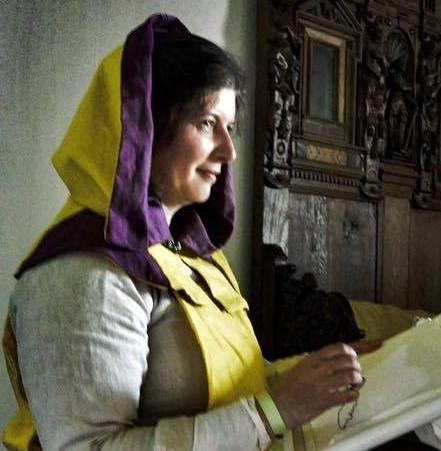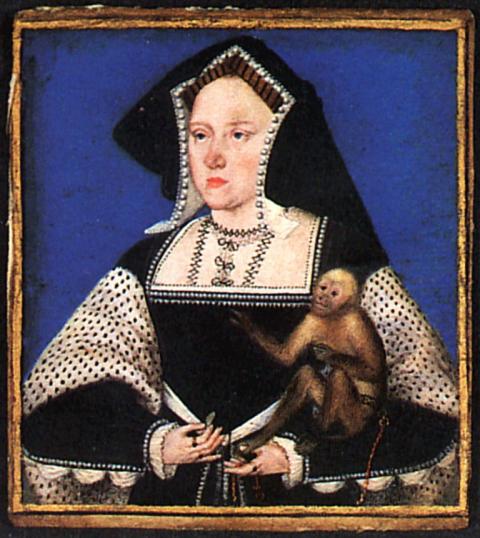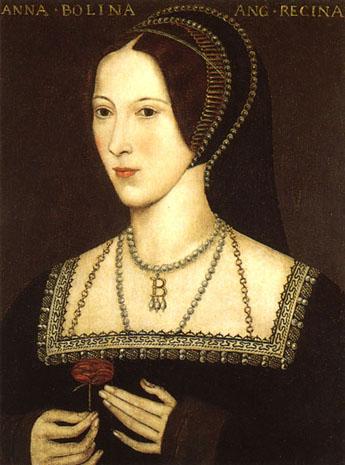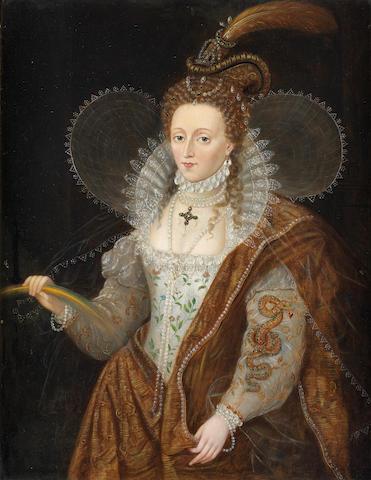Clothing and Power in the Royal World of Catherine of Aragon, Anne Boleyn, and Elizabeth I
At President Trump’s 2019 State of the Union speech, “the women of the US Democratic party dressed in unanimous white” to make “a powerful statement that the status quo in Washington will be challenged” (Independent 2019). In the 1960s, women burned bras in support of women’s rights. In the late 1500s, Queen Elizabeth I took the reins of England, despite opposition, by creating a powerful image using clothing as one of her tools. These are only a few examples of how women throughout history have used clothing to advance their agenda, form their own alliances, and defend their interests.

The author, Niki Toy-Caron. Spøttrup Castle, Denmark 2017. Photo by Jana Brooks.
As a child, I watched my mother dress in suits with giant shoulder pads to fit into the corporate world of men, with my father’s favorite song about hiding his long hair to fit in echoing in my small head (Five Man Electrical Band 1970). I started making my own clothes as a child, and that has turned into a small business specializing in medieval and fantasy clothing. My passion for garments inspired my interest in historical clothing and in turn history, and I recently graduated with my bachelor of arts in history from the University of New Hampshire at Manchester.
The study of powerful women throughout medieval and American history was a large part of my studies, and the desire to pair two of my passions led to my capstone project. This project, Women’s Fashion in the Tudor Court: A Demonstration of the Use of Power Through Articles of Clothing, focused on the Tudor court from 1509 to 1603, which included Henry VIII’s six queens and his two daughters. The title Queen seems like it would be one of power, yet that was not the case. Men held the power, and these women had to find ways to express themselves and exert power and control through whatever means they could. As my research for this project showed, these women found ways to use clothing to advance their political and personal agendas.
Multidisciplinary Research
Fashion history is a newer branch of the study of material culture, and scholars had done little on the subject of clothing at the Tudor court until the recent work by Eleri Lynn and Maria Hayward (Lynn 2017, Hayward 2007). My research, under Professor John Cerullo’s guidance, started with a look at what had been done in the field of fashion history. I found that much of fashion history was descriptive of the actual materials, such as the changes in color trends and availability of materials through the course of fashion style. Very few studies had been done with a focus like mine, but these studies gave me a look into the kind of research I would need to do.
Material culture often requires multidisciplinary research into subjects such as law, art, and commerce (e.g., domestic and textile inventories, marketing) to answer such research questions as, Why did the Tudor queens and princesses wear what they wore? Who were they talking to? and What were they trying to say and to whom? These questions led me beyond the current fashion style into the motivations for their clothing choices.
Discovering Eleri Lynn’s Tudor Fashion: Dress at Court 1485–1603 and Maria Hayward’s Dress at the Court of King Henry VIII was like opening a treasure chest. These two books were the first I found that contained the type of knowledge and sources I needed. From there, I delved into biographies of the Tudor women themselves and of Henry VIII. Although King Henry VIII was not the subject of my study, there is an abundance of information on him, his household, and his holdings. In addition, the biographies of his wives and daughters often had details about the clothes they wore or other references to investigate. As I dug through royal inventories, I had to compare what I found with information in their biographies and with representations of these lovely ladies in artworks of the time. There is a plethora of information, so much so that deciding what to exclude was a chore. For example, in researching King Henry VIII’s inventories I found detailed descriptions of some of the sixty-five pairs of sleeves Queen Jane Seymour owned.
Many letters that passed between courtiers held clues about why gifts of clothing were given and how they were received. These women’s skills of manipulating politics and relationships using clothing was often much more subtle than the burning of bras, but the outcome may have been just as powerful.
Historical Background
King Henry VII, 1457 to 1509, founder of the Tudor dynasty, was known as a miser, but he spent lavishly on clothing because he knew that he had to look the part of a king to be accepted as such. He passed this pride in adornment on to his son, Henry VIII; to Henry’s wives; and to his court (Lynn 2017). The Tudor court of sixteenth-century England produced women who used clothing to artfully walk political and emotional tightropes and had the resources to effectively express themselves through dress.

Portrait of Henry VIII of England by Hans Holbein the Younger ca. 1537, showing Spanish goldwork around the collar.
I have chosen three women to concentrate on for this article, because of the quality of information on them. They are Catherine of Aragon, Henry VIII’s first wife; Anne Boleyn, Henry’s second wife; and Elizabeth I, Henry’s daughter with Anne Boleyn. Catherine of Aragon and Anne Boleyn are the wives to whom Henry was married longest and the two whose use of garments is most notable. Elizabeth I reigned for forty-four years after short reigns by her siblings, Mary I (daughter of Catherine) and Edward I (son of Henry’s later wife, Jane Seymour). During Elizabeth’s reign, she used clothing to portray whatever image she felt necessary at that time to keep her place in the country.
Catherine of Aragon was born to Ferdinand and Isabella of Spain, two of the most powerful monarchs of the time, and raised to be a queen. Although Catherine’s mother was known for being a strong queen in her own right, England was afraid of having a female inherit the throne, and so fathering a male heir was considered a high priority for every king. The match between Henry and Catherine appeared to be one of true affection until it did not produce that heir. Catherine had many miscarriages and stillbirths, but only their daughter Mary I survived. With no male heir, Henry was open to persuasive mistresses who wanted to be his new queen.
Anne Boleyn was an English mistress but raised in France. The Boleyn family were well placed amongst the gentry, and Anne was selected as one of Queen Catherine’s attendants thirteen years into the rule of Henry and Catherine. Henry was looking for an heir, and Anne was looking for a crown. In order to marry Anne, however, Henry VIII needed to divorce Queen Catherine of Aragon. As a devout Catholic, he tried first to get the pope’s approval. After years of papal denials, he broke with the Church of Rome and created the Church of England, headed by himself, to get the new bride he wanted.
Henry’s decision to break with Rome was difficult and had some world-changing consequences, including the success of the English Reformation. I grew up within the Christian faith and can understand how hard it must have been for Henry to break with the church. While Henry negotiated with the pope and the Roman Catholic Church, and throughout the ensuing drama as he divorced Catherine, married Anne, and eventually executed Anne, the women in his household continued the struggle for his affections and power.
One of the tools these women could use to exert their power was the Great Wardrobe. The Great Wardrobe was the department of the king’s household responsible for all his and his family’s garments. It was sometimes known as the Royal Wardrobe or the King’s Wardrobe. This department was responsible for the jewelry, the armor, and the fabrics required to make said garments (Lexis of Cloth and Clothing in Medieval Royal Wardrobe Accounts 2017). Control over the budget of the wardrobe would allow the queen or mistress to dress for success. As a single mother in the working world, I understand how important that budget can be. The ability to present yourself properly can be crucial. The search through my diverse sources led me to several prominent examples of how these women used clothing to exert power.
The Power of Clothing
Catherine of Aragon
When Catherine of Aragon realized that a mere mistress was trying to take her place, she tried to use her power as queen to keep her rival, Anne, in her place. She used her power within the Great Wardrobe to increase her clothing budget by 50 percent. I learned that she did this in the hopes that she would look more attractive to her fashion-sensitive husband and that by dressing in more expensive fabrics she could put a mere lady-in-waiting in her proper place (Lynn 2017). “After Archbishop Cranmer had granted a divorce to Henry VIII from her in May 1533, Catherine provocatively ordered new livery for her household embroidered with H and K, as though she was still married” (Hayward 2007, 305). Power over the Great Wardrobe was a battleground for Catherine and Anne during the years the two remained at the same court, basically sharing the same household, while Henry fought to dissolve his marriage to Catherine.

Catherine of Aragon (m. 1509-1533) wearing the English gable hood. Katherine of Aragon by Lucas Hornebolte ca 1525-1526.
Another way Catherine of Aragon exerted power was demonstrated by the clothing fashions she brought to court that reflected her Spanish heritage. Spanish royal fashion often set the standard for other countries, as seen by Henry’s sister Mary Tudor adopting the farthingale into her wardrobe (Leed 2020). “Catherine of Aragon is credited with introducing the farthingale to England when she arrived in 1501” (Hayward 2007, 162). The Spanish farthingale is a hooped petticoat that gave a rather triangular shape to the skirt. The triangular shape of the skirt became more pronounced in later years. Catherine and her Spanish court also brought a needlework called black work to the English court that, because of its origination in Spain, became known as Spanish work. Spanish or black work generally appears in meandering scrollwork along collars and cuffs (Hayward 2007). I observed this needlework in both black and gold in some of the images of Catherine and Henry.
Although Catherine’s clothing was Spanish, her heart was Henry’s, and her devotion was demonstrated not only through her influence on his clothing but through her touch on his kingdom. The farthingale became popular; so did black work, both as a fashion and as a skill. Catherine did not lose all her power when she was banished from the court. In fact, she is credited with creating the English cottage industry of household needlework while in her banishment. Her example of dressing and embroidery led those around her to step out of their quiet roles of housewife to add to their incomes (Weir 2002). Thus, Catherine’s use of clothing for power had long-lasting effects.
Anne Boleyn
Fashion historian Maria Hayward writes that Anne Boleyn used her clothing to mark her transformation “from a mistress into a wife (without success with Eustace Chapuys, an ambassador of Spain and devotee of Catherine, who never stopped calling her the concubine)” (Hayward 2007, 178). Anne was raised in France and supported everything from that country. For her coronation, Anne dressed in the French fashion accompanied by “12 members of the household of the new French ambassador” who led her procession (Hayward 2007, 48). Anne’s choice to not only wear French clothing but to surround herself by French people upon becoming an English queen was almost an affront to the English people, who had fought numerous wars with the French. Despite her French coronation attire, the medal that was struck in the mint in her honor “depicted Anne wearing an English gable head-dress” and English-styled clothing (Hayward 2007, 48). Presenting her as an English woman was a clear choice to gain support for her among the English people (Hayward 2007).

Anne Boleyn (m. 1533-1536) wearing the French hood. Anne Boleyn by Unknown English Artist late 16th century.
When her daughter Princess Elizabeth was born, Anne Boleyn attempted to demonstrate her new power as queen and mother of the newest princess by demanding that Catherine of Aragon send the christening gown worn by Catherine’s daughter Mary to the new queen. “Catherine of Aragon refused to send Anne Boleyn the christening robe that she had brought from Spain, stating, ‘God forbid that I should ever be so badly advised as to give help, assistance, or favour, directly or indirectly in a case so horrible as this’” (Hayward 2007, 58). Anne as queen would now have power over the Great Wardrobe and all clothes belonging to the crown, but the gown was a personal item belonging to Catherine. This disagreement over a piece of clothing required the king’s intervention. King Henry decided in favor of Catherine.
Throughout her time as queen, Anne Boleyn’s French hood became a symbol of those who supported her, and would eventually represent Protestant beliefs when the king’s choice of Anne over Catherine led to a new Church of England. Those who supported her in the English court would wear the French hood, and those who supported Catherine of Aragon would wear the English hood. Anne herself forsook the French hood when she faced the executioner: “[T]hey removed an ermine cloak which she had on, and she herself took off her head-dress, which was in the English fashion”(Norton 2013, 362). Anne was clearly attempting to make amends at the end, possibly because she knew her daughter Elizabeth would need protection after her death. Anne, who had come from lower beginnings, used clothing to demonstrate her gain in rank and demonstrate her loyalties.
Elizabeth I
Elizabeth, Anne’s daughter, would eventually follow Mary I to the throne of England as the Protestant Queen Elizabeth I. She had learned much from the women and men who came before her in the Tudor court. In fact, Elizabeth would use clothing as an effective tool for her forty-four-year reign. Despite opposition to her unwed status, Elizabeth remained single for the entirety of her reign, using her virginity instead as a trademark. She used clothing to create an image of both purity and manliness, assembling from varied sources an image of power that allowed her one of the longest reigns England has known.

Elizabeth I (r. 1558-1603). The Rainbow Portrait by Isaac Oliver.
In the pursuit of this distinctive image Elizabeth adapted to a broader shoulder style that developed in the later years of the sixteenth century for women. Dress bodices began to look like men’s doublets. The farthingale became larger and more popular. The neck ruff, which was popular in Italy, became a trademark look for Elizabeth, and she developed it to almost ridiculous proportions. Women were using clothing to physically occupy more space as if by doing that they could gain physical prowess and power. For Elizabeth, at least, it seems to have worked. Eleri Lynn describes the “Rainbow” portrait of Queen Elizabeth I as the "embodiment of Tudor majesty. By 1602, when this portrait was painted, Elizabeth was nearing the end of her life, but is shown here as youthful and timeless . . . Her robe is painted with eyes and ears to show that she sees and hears all. A jewel-encrusted appliqué serpent adorns her sleeve, a symbol recognizable to sixteenth-century observers as Intelligenza or wisdom, along with the red heart-shaped jewel above it that denotes the mercy necessary for making wise choices." (Lynn 2017, 12).
To assume the power of a king and reign as an unwed queen, Elizabeth needed to dress for the role. Yet because Elizabeth refused to marry, it was equally imperative that she retain an image of purity. Elizabeth did this through modest clothing and extremely pale makeup. Her combination of the manly style, makeup, modest clothing, and iconography created the Virgin Queen image by which she is still remembered. Her image gave her the power to walk the political line remaining unwed and childless yet wielding power as effectively as any man. She often had paintings done positioning her Virgin Queen image on top of images of the kingdom itself, to remind others of her power.
Final Thoughts
Women have battled politically and socially using clothing for centuries. In the United States, women burned bras in the 1960s to make a feminist statement. The women of the 1980s attempted to find their places in the United States corporate world by wearing broad-shouldered power suits that were reminiscent of Elizabeth I’s manly style. Henry VIII’s first two wives battled each other using the resources of the Great Wardrobe and divided a country. One of their daughters, Elizabeth I, created an iconic image to stand as a powerful woman in a male world.
These Tudor women used clothing to exert some influence over a world in which they had little to no control over their circumstances or often even their own bodies. Women’s clothing through the ages intrigues me still—not only what they wore, but why they wore it. Were there similar powerful displays in the past that have not yet been discovered? Are women still dressing like men to secure jobs, status, power? I hope to find the opportunity to pursue these questions and more as I broaden my research into this new field when I attend graduate school in the future. My capstone project gave me a deeper understanding of how women of the past chose their clothing and how women today still carefully create their image through clothing. It has only deepened my passion for sewing, and I look forward to upcoming historical costuming projects.
First, I would like to extend a huge thank-you to my mentor, Professor John Cerullo, for his enduring patience and support throughout not only this project but the many years of my undergraduate studies. I would like to thank the UNH and UNHM library staff for their guidance and availability, and for putting away the hundred or so books I took out. My passion blossomed under the influence of the humanities professors at UNH and UNHM and their influence will remain with me. I need to thank Meredith; I could not have done the undergraduate work that led to this project without her having my back on the home front. To my children, I cannot thank you enough for your patience, your love, and your help editing when I had looked at my work for too long.
References
“The Rise of Protest Dressing: How Fashion and Politics Are More Intertwined than Ever.” 2019. Independent.ie, 2 March. www.independent.ie/style/fashion/style-talk/the-rise-of-protest-dressing....
Hayward, Maria. 2007. Dress at the Court of King Henry VIII. New York: Maney Publishing.
Leed, Drea. “The Spanish Farthingale.” 2020. History of the Spanish Farthingale
Lexis of Cloth and Clothing in Medieval Royal Wardrobe Accounts. 2017. “The Great Wardrobe.” Lexis of Cloth and Clothing in Medieval Royal Wardrobe Accounts, 29 Jan. 2017, medievalroyalwardrobelexis.wordpress.com/the-great-wardrobe/.
Lynn, Eleri. 2017. Tudor Fashion: Dress at Court 1485–1603. New Haven, CT: Yale University Press.
Norton, Elizabeth. 2013.The Anne Boleyn Papers. Stroud, Gloucestershire, England: Amberley Publishing.
Weir, Catherine. 2002. Henry VIII: The King and His Court. New York: Ballantine Books.
You can find the lyrics for “Signs” by the Five Man Electrical Band here: https://www.songfacts.com/lyrics/five-man-electrical-band/signs
Author and Mentor Bios
Niki Toy-Caron graduated in May 2019, summa cum laude, from the University of New Hampshire at Manchester (UNHM), with a bachelor of arts degree in history. Niki is from Milton Mills, New Hampshire. She completed her degree while raising her five children as a single parent. Her research was done for her senior colloquium, and in addition to writing this research paper, she presented it at the UNH Manchester Undergraduate Research Conference in 2019. Her research topic germinated with a paper on the headdresses worn by Anne Boleyn and Catherine written in a class about Henry VIII. By conducting her research, Niki discovered that she loves digging for new information, but that deciding what information to include in her research is challenging. She says that weeding through disinformation is disheartening, but because she discovered the lack of information on the subject of fashion history, she has been considering more research on the subject. Niki hopes to someday work in a museum, preferably focusing on clothing or fabrics.
John Cerullo has been at the University of New Hampshire at Manchester since 1981, when it was Merrimack Valley College. He coordinated the UNH history program at UNHM from 1988 until his retirement in 2018; he is currently an adjunct instructor there, with the title of Professor Emeritus of History. Dr. Cerullo previously mentored Inquiry authors Devon Mercer (2006), Randall Lawrence-Hurt (2010), and Sam O’Brien (2014). As a veteran mentor, he feels he gains “the enormous satisfaction of seeing a seed I have planted grow into something substantial and self-sufficient, thanks entirely to the work and talents of an ambitious, self-motivated student.” In the process, he says, he has “wound up learning far more about the subject than I have taught.” He thinks learning to write is vitally important for history students, and that writing for Inquiry is an excellent opportunity for them to gain those skills. Dr. Cerullo describes Niki as “one of the most resourceful, imaginative students” he has ever taught. Her approach to the study of history is, in his words, “passionate, and immersive. Niki attempts to almost inhabit the past. The result is a special depth of understanding, reflecting both her rigorous examination of primary sources and a quality of empathy that is all her own.”
Copyright 2020, Niki Toy-Caron
